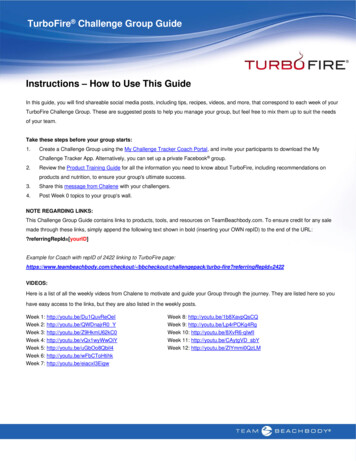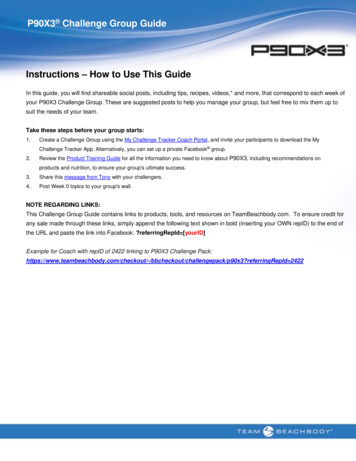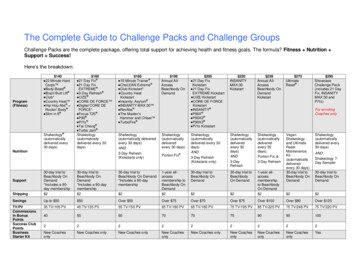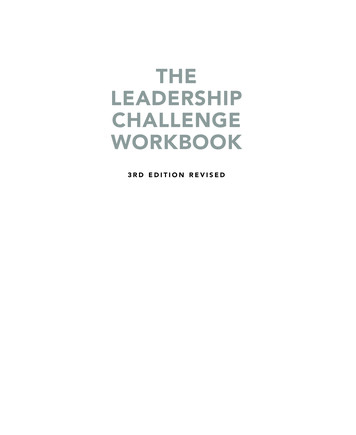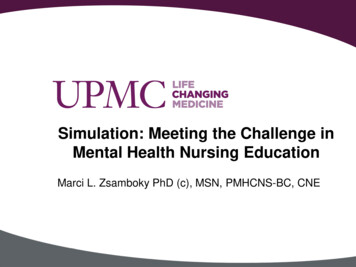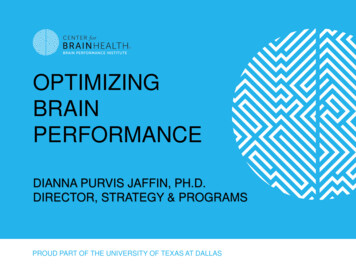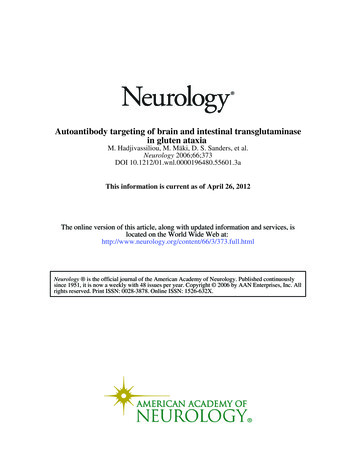
Transcription
Brain Health 101Challenge Workbook
Table of ContentsWelcomeMake a plan and move forward beyond the Brain Health 101 Challenge.1-2OngoingExerciseSet goals and track your progress one step at a time.3-5Eat RightAdd brain-healthy foods to your diet and swap out unhealthy choices.6-8EngageYour BrainLearn more new ways to keep your mind active and alert.9-10RestorativeSleepClean up your bedtime habits to get the most out of your shut-eye.11-14ManageStressPractice some novel ways to manage stressors.15-17Be SocialExplore how to build more relationships and add diverse socialinteractions to your life.18-20Brain Healthfor LifeKeep going and growing for the rest of your life.21-24AARP and the AARP Logo, and Staying Sharp, are registered trademarks of AARP. This material is subject to copyright lawand may not be used, printed or reproduced without the express written consent of AARP.2021 AARP. All rights reserved.Please consult with your healthcare provider before adopting new health practices or physical fitness routines.StayingSharp.org
WelcomeIt’s not called a challenge for nothing!Changing habits and adopting new ones is a challenge.This companion workbook is here to help you succeed.Here’s how it works: You’ll apply what you learned in the Brain Health 101 Challenge anduse that knowledge to build a lifelong plan to a healthier lifestyle. Each section in this workbook recaps key takeaways fromthe six pillars of brain health, then asks you to list practicesyou’ve already taken up from the Challenge. Finally, you’ll learn how to adopt new practicesthat will move you forward to meet your goals.Brain Health 101 Challenge W E LCO M E1
Ask Yourself:Brain-Healthy HabitsFirst, where are you now after completingthe Brain Health 101 Challenge?Answer these questions:Which habits have you learned are good for your brain?Which are now a regular part of your routine?Which are not things you do very often?Of these that are not part of your routine, which could you realistically adopt in the next few weeks?Now, let’s get started with the first pillar, Ongoing Exercise.StayingSharp.orgBrain Health 101 Challenge W E LCO M E2
Ongoing ExerciseKEY TAKEAWAYSYou learned about exercise in the Brain Health 101 Challenge: Regular exercise can help stave off changes that happen in your brainas you get older and help you hold on to memory and thinking skills It’s never too late to take up exercise that may benefit your brain and body All types of workouts potentially offer rewards for the brain, so mix it upAsk YourselfWhat’s my current exercise routine?How much more time do I have to give to exercise (so I can build up to 150 minutes a week)?What’s my starting goal for today or this week? You may want to think in terms of minutes, varietyor how hard you are exerting yourselfPlease consult with your healthcare provider before adopting new health practices or physical fitness routines.StayingSharp.orgBrain Health 101 Challenge O N G O I N G E X E RC I S E3
Never Too Little, Too LateIf you haven’t yet begun, make a plan to start today.You’re never too old to exercise, and any amount is beneficial. If you can’t fit 30 minutes of physical activity at one time into yourschedule, it’s OK to break it up into shorter sessions of 10 minutes each. When you begin strength training, start with just your body weight(such as with lunges, push-ups and sit-ups) before you move on toweighted equipment. When that feels easy, it’s time to progress. If you stick with it, what you find challenging today will feel easy in the near future.How To Adopt a New Exercise HabitFive key factors predict whether you’ll continue and stick with an exercise plan.Enjoyment – Pick a form of exercise that you like and will keep doing.Confidence – You’ll stick to an activity if you feel like you know what you’re doing. Get a friend, familymember, trainer or gym staff to teach you how to use the equipment or show you proper form.Social Support & Accountability – Exercise with friends, family or a group. You are more likely tostick with your plan when you have support and when someone expects you to show up.Integration into Daily Routine – Put your workout on your calendar or in your smartphone tostrengthen your commitment to it.Exercise muscles releasesproteins in the blood that arecarried to the brain and mayhelp the brain regenerate.The antidepressant effect ofrunning leads to the growth ofnew cells in the hippocampus,a brain region that plays a bigpart in learning and memory.KEEP GOING!Walk Your Way toa Better MemoryStayingSharp.org6 Ways to Get Past theExcuses and Start MovingWork Small Bouts ofExercise Into Your DayBrain Health 101 Challenge O N G O I N G E X E RC I S E4
Mix It UpWorking out can bring many benefits to the brain. Make a plan to try a differenttype of exercise every week.Decide what you’ll do for each type of exercise (or follow the plan shown below). Place acheck mark next to the workout after you’ve done it and try a new one the next week.ExamplesAerobicPlan a long bike ride fora Saturday morning.StrengthSee how many push-upsI can do.StretchFind a guided stretchroutine online.BalanceDo a short video of tai chi forbeginners. Search on YouTube.NewActivityYou decide! What activitywould you like to try?My PlanCome back to check in on: / /How’d you do? How will you move forward? What’s your next step? (Example: I started outwith a 10-minute walk three days a week. Now I’m going to increase to 20 minutes.)Don’t get discouraged. Research shows it takes an average of 66 days to makea new practice a habit. And it could take as many as 254 days, so keep pushing!StayingSharp.orgBrain Health 101 Challenge O N G O I N G E X E RC I S E5
EatRightKEY TAKEAWAYSIn the Brain 101 Challenge, you learnedabout nutrition and healthy eating: What you feed your body, you feed your brain A heart-healthy diet is a brain-friendly diet. Emphasizeplants, including leafy greens and berries, and leanprotein, and limit red meat, saturated fat and added sugar The brains of people who eat healthy foods most of thetime may age more slowly than those of people whoconsume less nutritious foodsAsk YourselfHow healthy is my diet?Which brain-friendly foods described in step 3 of the Challenge do I always eat (such as wholegrains, leafy greens, berries and fatty fish)?Which do I never eat?What’s a realistic swap (exchanging an unhealthy food for a healthy one) that I could make this week?StayingSharp.orgBrain Health 101 Challenge E AT R I G H T6
A Healthy Diet Nourishes Your BrainThere’s no secret to a brain-friendly diet. An overall healthy dietis good for your brain.Make a plan to integrate more fruits and vegetables, whole grains, fish and other healthy fats and toreduce your intake of red meat, and try healthy spices in place of salt. Fill in the chart with your ideas.ExamplesMy PlanVegetablesReplace potatoes or fries with a leafy greenone day this week.FruitsSwap one salty snack out for a handfulof berries.FishReplace another meat with a serving ofmackerel or salmon this week.Whole GrainsReplace white rice with brown rice, or whitebread with whole wheat.SpicesUse less salt at dinner one night, andexperiment with spices.Come back to check in on: / /How’d you do? (What have you accomplished so far? How would you still like to improve?)How will you move forward? What’s your next step? (Example: I swapped out red meat for salmona couple times in the past few weeks. Now I’d like to try other fish that’s high in omega-3 fattyacids and eat fish twice a week.)StayingSharp.orgBrain Health 101 Challenge E AT R I G H T7
Heart-healthy Foods Brain-friendly FoodsBlueberries & StrawberriesMore of these throughout lifemay slow the loss of thinkingskills by up to 2.5 years.Green Leafy VegetablesOne serving is linked to alower risk for dementia.Whole GrainsThe B vitamins in wholegrains, like whole wheatbread and brown rice, mayhelp preserve brain function.QUIZ: Good Fats vs. Bad FatsFat isn’t all bad; your body and brain need it for fuel. Good fats help build cells and protect nerves.Bad fats can clog up your arteries and slow blood flow, including to your brain. Do you know whichof these foods contain good fats and which ones contain bad fats? Put an X in the correct column.FoodGood FatBad FatSteak (and other red meat)Whole milk (and other full-fat dairy)1 TO 2Number of servings offatty fish it takes eachweek to get brain benefits.Olive oil (also soybean, canola and peanut)Prepackaged baked goodsAvocado5Salmon (and other fatty fish)MargarineNumber of weekly servingsof seeds (sunflower, etc.)that can reduce the bodyinflammation connected tomany chronic diseases.Most nutsSoymilkFlax, chia and sunflower seedsAnswers: Steak – bad; whole milk – bad; olive oil – good; prepackaged baked goods – bad;avocado – good; salmon – good; margarine – bad; nuts – good; soymilk – good; seeds — goodKEEP GOING!Stay Hydrated toSupport Brain HealthStayingSharp.orgPractice Two BrainFriendly Days of EatingMake It theMediterranean WayBrain Health 101 Challenge E AT R I G H T8
Engage Your BrainKEY TAKEAWAYSIn the Brain Health 101 Challenge you learnedabout keeping your mind active, healthy and strong: You have to engage the brain, like a muscle Learning a new skill engages your mind and changes your brain Activities that require you to stay alert, such as reading ratherthan watching TV, stimulate your brain, tooAsk YourselfWhen was the last time I learned to do something new?Am I more likely to pass the time with TV or do I choose activities like reading, solving a puzzle orcooking from a recipe?What’s a realistic way that I could choose to stimulate my mind, rather than run autopilot this week?StayingSharp.orgBrain Health 101 Challenge E N G AG E YO U R B R A I N9
Switch Of f Autopilot; Switch on Your BrainMake a plan to engage your brain. Opt out of activities that are second-nature to you and dosomething that requires you to think. Fill in the chart with mind-activating swaps you can make.Old ActivityNew ActivityShop at the same supermarket as always.Go to a different supermarket where I’ll haveto look for all the things on my list.Watch TV.Read a novel.Take the same route to work, church or the store.Plan a new route before you leave the house.Master a New SkillBased on the things you already know and like to do, choose askill to learn, practice and master. Bonus challenge: Learn thenew skill or play the new game with a friend. If you like sewing try needlepoint, cross-stitch or knitting. If you like travel try a few lessons in the language of a countryyou’ve always wanted to visit. If you like cooking follow a recipe to make a type of cuisine, maybefrom a culture different from yours, that you’ve never prepared.People over 50 who watchTV for 3.5 hours a day ormore seem to lose verbalmemory at a faster pacethan those who spend lesstime in front of the tube. If you like crosswords practice and become good at another typeof puzzle or game.KEEP GOING!Give BallroomDancing a WhirlStayingSharp.orgStart an IndoorHerb GardenConsider Learning aNew InstrumentBrain Health 101 Challenge Find a NewHobby OnlineE N G AG E YO U R B R A I N10
RestorativeSleepKEY TAKEAWAYSHere’s what you learned in theBrain 101 Challenge: While you sleep at night, your brainclears out waste and sorts and catalogsmemories from the day Your brain needs enough sleep both tofunction on a day-to-day basis and topreserve brain function over time Long-term lack of sleep seems to increaselevels of a protein linked to Alzheimer’sAsk YourselfAbout how much sleep do I get every night? How much sleep would I like to get?How long does it take me to fall asleep? Do I sleep through the night?Do I have any unhealthy habits that could be keeping me up? What are they?What’s a habit I could realistically work on changing this week?StayingSharp.orgBrain Health 101 Challenge R E STO R AT I V E S L E E P11
Sleep Diary, Pt 1Did you find room for improvement in your sleeping habits?Let’s dig deeper. Keep track of your sleep for a week and find out exactlywhat you can change to help you sleep better.Before bed each night, record the following information about each day:Su# ofcaffeinateddrinksand AMAMPMPMPMPMPMPMPM# ofalcoholicdrinksand when# of napsand whenDurationof napsTotal # ofworkoutsand whenDuration ofworkoutsHow sleepyyou feltthat day1 (a little) - 3 (a lot)Medicinesyou tookWhat timeyou wentto bedStayingSharp.orgBrain Health 101 Challenge R E STO R AT I V E S L E E P12
Sleep Diary, Pt 2Every morning, record the following information about the night before:SuMTWThFSaHow long ittook to driftoff to sleeplast nightWhat timeyou woke upthis morningAMAMAMAMAMAMAMWhat timeyou wentto bedlast nightPMPMPMPMPMPMPMWhat timeyou got outof bed thismorningAMAMAMAMAMAMAMHow manytimes youwoke inthe nightHow restedyou felt inthe morning1 (not) - 3 (very)Check back in one week on: / /How are you doing?Are there habits you could change to get better sleep? (Example: I have trouble falling asleep atnight when I drink coffee in the afternoon. I’m switching to decaf coffee or herbal tea after noon.)StayingSharp.orgBrain Health 101 Challenge R E STO R AT I V E S L E E P13
Create a Healthy Bedtime RoutineA relaxing regimen tells your body it’s time to wind down for sleep.Here’s how to create yours: Follow the same steps, such as washing your face, brushing your teeth and putting on pajamas,every night to signal to your body that it’s time to settle down. Lower the lights. When it gets dark, your body is better able to produce a hormone called melatoninthat helps you sleep. Turn off overhead lights, dim your lamps, and power down your screens. Give yourself time to wind down with a calming activity (you might aim for 30 minutes beforesleep). This should be a screen-free time. During this time you could read, write in a journal, stretch,take a bath, listen to soft music, meditate or do some other relaxing activity. Get into bed at the same time every night. But don’t lie there tossing and turning. If it takesmore than 20 minutes to fall asleep, get up, and resume your calming activity until you’re readyto try to sleep again.Sweet SlumberThese techniques may help you calm your mind and fall asleep: Picture yourself asleep: Close your eyes and conjure an image of yourself sleeping peacefully.Or picture another calming scene. This is called guided imagery. It may take some trial and errorto come up with the image that works for you. Worry at another time: If it’s your to-do list that keeps you up at night, set aside a little time tothink about these concerns earlier in the day. Jot down the problems you need to solve. This mayhelp prevent stress from interrupting your sleep. Focus on your breathing: Turn all your attention to your breath. Imagine the air coursing throughyour body as you inhale and exhale. Often, focusing intently on your breath helps you to let go ofother thoughts that might keep you awake.43 %Percentage of people age50 and older who say theydon’t get enough sleep.FACT:People can change theirbehavior at any age andimprove their sleep.KEEP GOING!Blow Off InsomniaStayingSharp.orgClear and Calm YourMind to Sleep BetterFind Your PerfectSleep TemperatureBrain Health 101 Challenge R E STO R AT I V E S L E E P14
Manage StressKEY TAKEAWAYSIn the Brain Health 101 Challenge you learned: Constant stress leads to inflammation that may raise the riskfor numerous chronic conditions, some affecting your brain You can’t eliminate all stress from your life. Some stressis simply inevitable. You can soften the blow on your body with meditation,exercise and other stress management techniquesAsk YourselfOn a scale of 1-10, what’s my stress level on an average day?Are there unnecessary stressors in my life that I could eliminate?Do I have a healthy habit to help manage the stress I can’t eliminate? What is it?Is there a stress management technique from the Brain Health 101 Challenge that I couldrealistically try this week?StayingSharp.orgBrain Health 101 Challenge M A N AG E ST R E SS15
Take Control of StressDid you identify a stress management technique from the Challenge thatyou could reasonably take on this week?Try this: Set aside a few minutes each day to reduce stress. If you already know which technique(s)you prefer, schedule the same one for each day. If not, explore and try a new one every ationTake a walkYoga or Tai ChiWorkoutLaugh along toa funny videoCheck back in one week on: / /How did you do?Which technique was most enjoyable or most effective?How can you incorporate it into your daily routine?StayingSharp.orgBrain Health 101 Challenge M A N AG E ST R E SS16
Te Good and the BadMake a plan to manage your stress.Short-term stress that lasts minutes or hours may boost your immune system. Constantstress over months or years, on the other hand, may cause inflammation that can make youmore disease prone. Here’s some examples of what could cause good and bad stress.“Good” Stressors“Bad” StressorsYou’re late to work; better hurry or you’ll miss themorning meeting.You’ve been under pressure at work foryears. It affects your sleep and your mood.You’re throwing a party on Friday, and you’ve stillgot a lot to do.You are in an unhappy marriage.You’re studying for an important exam.You are still affected by childhood trauma.You are the primary caregiver for a sickparent and have no time for yourself.MYTH:Stress is bad for your health.Not always. Short-term bouts ofstress are good for you and mayboost your immune system.FACT:Some people can functionwell under extreme chronicstress. Others are less resilient,but people can learn how torespond better to stress.KEEP GOING!Try Forest BathingStayingSharp.orgGet Stress Squared AwayWatch a Top ComedyBrain Health 101 Challenge M A N AG E ST R E SS17
Be SocialKEY TAKEAWAYSIn the Brain 101 Challenge you learned about beingsocial and making connections: The brain thrives on social interactions People who are lonely tend to lose their thinking skills faster as they age Research shows that social activity, a strong network and access tosocial support can all help maintain brain functionAsk YourselfDo you have a social life?How often do you socialize in person, online or by phone?What types of social interactions are most meaningful, most purpose-giving for you?What’s a simple way that you could incorporate one more social activity into your life this week?StayingSharp.orgBrain Health 101 Challenge BE SOCIAL18
Get SocialDid you identify areas where youcould improve your social life?Make a plan.Keep a log of each of these socialinteractions when you have themor set them up this week.ActivityDateDetailsCall a friend to catch up.Get together with a friend in person (or by video).Make a new friend.Attend an in-person or video-based group activity(such as, a lunch, a book club, or an exercise class).Volunteer (such as. at a soup kitchen,an animal shelter).Check back in one week on: / /How did you do?How can you progress? (Examples: organize and host a group event for a few friends;attend an invent where you’ll know few people and have to meet new people.)StayingSharp.orgBrain Health 101 Challenge BE SOCIAL19
Purpose-Driven LifeYou can form new friendships and createlasting bonds with people who share yourvalues, an interest or a common purpose.Try getting involved with a group or organizationdedicated to a cause that matters to you. Take afew minutes to reflect on what gives you purpose.What kind of activity fulfills you? Feels meaningful?(Examples: making something with your hands; helpingothers; protecting the environment; continuing youreducation; caring for animals; traveling.)Can you find a way to turn that purpose-giving activity into a social activity?MYTH:FACT:Social activity is just for funand doesn’t have actual healthbenefits. Not so. In fact, peoplewho are loneliest tend to lose theirthinking skills faster as they age.Doing something purposegiving, like tutoring orvolunteering, can helpincrease brain activity.KEEP GOING!Stay in Touch WithLoved Ones VirtuallyStayingSharp.orgSend a SmileGiving Back Can HelpSome Discover PurposeBrain Health 101 Challenge BE SOCIAL20
Brain Health for LifeKEY TAKEAWAYSIn the Brain 101 Challenge, you learned about thebenefits of developing lifelong brain healthy habits: Many of the risk factors for dementia are within your control You can set SMART goals to reduce your risk and take control ofyour brain health You’re never too old to improve your brain healthAsk YourselfYou’ve been working hard to try out and adopt some new habits.Let’s see where you stand.YesDo I get 150 minutes of moderate physical activity every week?YesDoes my diet promote my brain health?NoYesDo I get at least seven uninterrupted hours of sleep every night?YesDo I have an effective outlet for stress?Is social activity a priority for me?StayingSharp.orgYesNoNoNoNoBrain Health 101 Challenge B R A I N H E A LT H FO R L I F E21
Be Smart, Set SMART GoalsNow that you know where you stand, set goalsto get yourself to the next level and practicethe pillars of brain health for life!Experts who help people establish and achieve personalor professional objectives often suggest that you seta SMART goal. That stands for specific, measurable,achievable, relevant and time-bound.Specific, for example, would be “Exercise for 25 minutes, five days a week,” as opposed to “Exercisemore.” Five days a week for 25 minutes is measurable, too. You have a specific number to hit so thatyou know you’ve kept your commitment.An achievable goal is one that you have the skills and the physical capability to do. Relevant meansthat the specific achievable goal aligns with your larger aim to, say, live va long and healthy life.Time-bound means that you give yourself a deadline by which you want to achieve the goal, ratherthan just the intention to “get around to ime-boundWalk briskly.25 min, 3 days/wkYes, I now walk15 min, 2 day/wkYes, I want to buildup to 30-min walksFor 4 weeks,then eStayingSharp.orgBrain Health 101 Challenge B R A I N H E A LT H FO R L I F E22
Five Activities that Exercise Your BrainLearn a new danceIt forms new connections in your brain.Expand your vocabularyWhen you learn a new word – perhaps unknownones you come across when you read – youexercise numerous parts of your brain.Work a jigsaw puzzleThis task puts multiple thinking skills to work atonce and may help protect spatial memory.Listen to musicBesides its effects on your mood, music canhelp you think outside the box and generatecreative solutions to problems.Redecorate or rearrangeMove the furniture, change the art on the walls, or re-paint.Even small tweaks to your everyday environment maypromote new brain cell growth.StayingSharp.orgBrain Health 101 Challenge B R A I N H E A LT H FO R L I F E23
Make Changes Now8 Health Risks It’s Not Too Late to Address to Maintain Optimum Brain Health123Get your hearing loss treated4Use diet and medication to get yourblood pressure under control5Keep your alcohol consumptionbelow two drinks or fewer a day formen or one drink or fewer for women,on days when you imbibe678Keep your weight under controlwith diet and exerciseQuit smokingGet help for your depressionPrioritize your social lifeKeep movingKEEP GOING!Create a Fitness GoalThat Is SMARTStayingSharp.orgTake an ExoticArmchair Vacation6 Simple Ways toNurture MemoryBrain Health 101 Challenge B R A I N H E A LT H FO R L I F E24
Congratulations!You’ve completed the Brain Health 101 Workbookand are on your way to improving your brain health for the rest of your life!The adult human brainweighs about 3 pounds,is about 2 percent of totalbody weight, and containsabout 86 billion neurons.You use all of your brain– not just 10 percent, asa common myth states –and it is always active.Take the Brain Health 101 Challenge with neurosurgeonand CNN chief medical correspondent Sanjay Gupta, M.D.,and learn about the healthy habits that support brain health.StayingSharp.org
Table of Contents . Welcome . Make a pla

